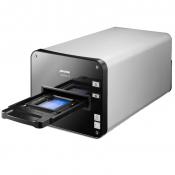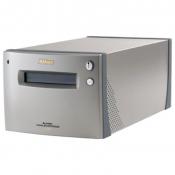Product Comparison: PLUSTEK OpticFilm 120 vs Nikon Super CoolScan 9000 ED
This site is a free online resource that strives to offer helpful content and comparison features to its visitors. Please be advised that the operator of this site accepts advertising compensation from certain companies that appear on the site, and such compensation impacts the location and order in which the companies (and/or their products) are presented, and in some cases may also impact the scoring that is assigned to them. The scoring that appears on this site is determined by the site operator in its sole discretion, and should NOT be relied upon for accuracy purposes. In fact, Company/product listings on this page DO NOT imply endorsement by the site operator. Except as expressly set forth in our Terms of Use, all representations and warranties regarding the information presented on this page are disclaimed. The information which appears on this site is subject to change at any time. More info


- Mutli-pass full-resolution scans of a 6x8 negative at 10,600 dpi do take some time to complete, but they're worth it.
- Working on it every day, on day ten I finally noticed that "scanner settings" is a thin line of text covered in orange, making it hard to read, and that allowed me to set size and resolution. I made a 5300 dpi scan with dust and noise reduction.
- To avoid the issue with very long scan times, you can take out the unsharp masking and dust removal. I prefer the multi-scan quality so I just live with that extra addition to the scan time.
- This is an excellent scanner. I purchased this after having used a Plustek 7200 35mm scanner. I was really impressed with the results compared to scans with my flatbed scanner. Scans are much sharper, finer detailed than a flatbed scan.
- I give it very high marks for scan quality and ease of use.
- It produces good scans but it can take a minute or two for each negative depending on the size of image required.
- It also scans a lot faster than what I expected. I think that some of the scan times that I've read about were probably done using computers with slower processors: I can scan a 35mm slide at 2400 dpi in about 15 secs or less.
- I'm not too technical on all the things that happen within the hardware-software process but the results an amateur like me can get are simply awsome. I scan the slides at a full 4000 bpi and store the results as huge TIFF files.
- The quality of this scanner is amazing. The detail that it picks up from slides and negatives is incredible.
- The scanresults have been better than hoped, and I can only recommend this scanner.
- The device has worked exactly as I had hoped allowing me to archieve hundreds of old negatives that would have been lost or cost much more than what I paid for it. I am very pleased.








- Size was a nice-to-have factor for me. I've already got a flatbed and ideally didn't want more space being taken up.
- A good bit smaller and quicker than the Nikon. It is a bit loud and clunky but is reliable and built well.
- The Plustek is very well built. It runs like a fine watch, except for the initial clunk that is heard at the beginning of a scan sequence.
- I've given 4 stars because the scanner is very well built and appears to work well.
- The OpticFilm 120 is well built and has impressively sturdy film carriers.


- There is no need to adjust it if your scans are from un-mounted film strips. I scan 120 film strips exclusively. All of my scans are sharp. I must confess that I'm a film guy.
- Basically, for medium format film it is so much better than the Epson that I would recommend it to anyone croping medium format or printing larger than 20x20 prints.
- The Silverfast software is not worth the effort to load it, a frustrating experience to say the least. If you buy this just bite the bullet and get Vuescan Pro, it is a pleasure to use and the learning curve is about five minutes.
- I have scanned 35mm negatives and color slides, and 120 negatives and color transparencies. I am very pleased with this versatile unit.
- Some light sharpening in Photoshop and you can hardly tell the difference.
- I also have used it with 35MM negatives and Kodachrome slides, which work beautifully, and with both 4.5cm x 4.5cm negatives and 110 negatives, which require that I jury-rig a special mask for the glass-covered medium format carriage (FH-869GR, not included).
- Aside from the very long wait, it seems that the scanner lives up to the hype. I'm still experimenting with it but so far its results are excellant. It's software is solid and very straightforward (thank God, for it's usually the opposite!).
- I shoot medium format 120 film and see this scanner supports up to 6x9 size negatives only due to the mechanical motor drive, though not the panoramic 6x12, 6x17 (FH-869S tray film holder supports up to 18cm) - which require stitching.
- My only complaint so far is that the 120 film hold doesn't hold the film flat. I guess I'll have to consider buying the overpriced glass film holder.
- The only drawbacks are that you have to scan bw negatives without Digital Ice (so you'll have a lot of manual cleanup to do) and the fact that there are no trays to scan 110 and 126 negative film (you could conceivably rig the existing trays to accomplish this).
- The problem I am having now is with the FireWire, which will not connect to my new PC. There are converters but the reviews on those are not good. The local PC repair shop says a FireWire card can't be installed in the computer; something about the motherboard.



